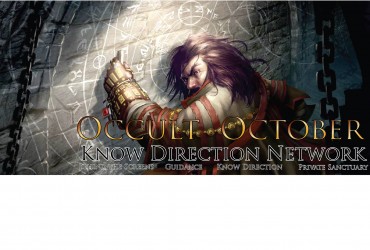This week Behind the Screens, we’re continuing our journey through the first level of RPGamer needs. Last time I laid some of the ground work of things to consider when hosting a gaming session. Most of that was logistical in nature and admittedly, sometimes gets in the way of actually playing the game. So today I want to focus on more narrative elements that work towards getting your players in the mood and keep them in-character. Given that this is the first week of our Occult October, I thought I might put some emphasis on creating and maintaining atmosphere in horror or spooky-themed games.
So lets start with the space. Once again you want your own dedicated area to game. Preferably quite and in the case of a horror-based game you probably want it dark. Not so dark as to make it hard to see what you’d need to, but dim enough to set an atmosphere appropriate the the narrative. Sometimes the way that dim lighting tends to lengthen the shadows on a persons face can make even the most jovial appearance turn sinister. That’s what you’re going for. Just enough of a shadowy element to help your player’s imagination run wild.
Next, consider music. There’s a reason that movie and video game productions focus so heavily on soundtrack especially when it comes to horror ambiance. Music has a wonderful way of hacking into primitive brains and letting us know if we should be angry, calm, energized, or afraid. Ideally the soundtrack for your game should be present but not overwhelming. Look to video game soundtracks for this as they are composed specifically with non-intrusiveness in mind.
Usually the first step in creating an engaging horror narrative is to get your audience invested in the fate of your protagonists. If the audience doesn’t form some sort of emotional connection with your protagonists as they go about their normal day-to-day then nobody’s going to care when the weird stuff starts happening. In this, most GMs have it easier than the average horror writer. Your PCs should, presumably, already be invested in their own characters. What happens when they don’t is the subject of an entirely different article.
The next step involves setting up what I think of as the three main components of a horror narrative. The first of these three is mystery. Something is wrong. Something is strange. Something has happened that takes the expectations that the protagonists have and skewed them. This could be a dramatic singular event, or a slow buildup. Often this is just a matter of perspective. For Rick Grimes, in the Walking Dead, the zombie apocalypse began as soon as he woke up in an abandoned hospital although his process of understanding what had happened was a gradual discovery. But for everyone else, the zombie apocalypse came like an inexorable tide. Obvious to everyone, but impossible to stop.
Which ties us into the next component, which is helplessness. Those in the skewed situation should find themselves powerless to remove themselves from it. While they can and certainly should be allowed the ability to resist and fight back, ultimately the despair that they feel is a part of the overall horror of the narrative. A large factor is this is isolation. The protagonists must come to realize that they’re all alone with little or no means of communicating with anyone outside their situation. Just as the protagonists help themselves, so too is no one around to help them. Isolation further underscores and emphasizes the protagonists’ sense of helplessness. There’s a reason why so many horror movies have such small casts. Because the story is about the protagonist and how they deal with their particular demons. Alone.
Which is all pointless without the final element, tension. Strictly speaking tension is an ever rising anticipation of a certain outcome. So, in the classic murder story, you see protagonists being picked off one by one. Tensions rise as the sole surviving protagonist faces off with the murderer in the final confrontation. Controlling tension is crucial to providing an immersive and terrifying experience for your players. The first key to this is appropriate foreshadowing. Did you leave enough clues to the nature of the mystery that you’re using to intrigue your players and hint at whatever dangers lie down the road? So say your PCs are exploring a dungeon. On the first level they find a good deal of evidence suggesting violence but no actual bodies – just broken furniture and rents in the wall. On the second level they find more broke things but also blood splatter here and there. On the third level there’s even more blood and dismember limbs or viscera. Finally they get to the stairs leading down to the fourth level and the passageway is slick with gore. What do you suppose they’ll find down there? No one knows. But everyone at the table has a guess.
But, Anthony, you say, “This is all well and good but how does it help me when I run my games?”
That’s a great question, dear reader. Running horror in the 3.5 D&D or its iterative systems presents a number of challenges all stemming from the fact that these systems wasn’t really designed with horror narratives specifically in mind. First, in a world of dragons, wizards, and fey who’s to say what is normal or not? Heck, there are spells in the Pathfinder Core Rulebook that literally allow you to create zombies. How do you create an atmosphere conducive to horror when the fantastic is situation normal?
Furthermore, when your PCs are capable of titanic feats of strength or breathtaking acrobatics, not to mention bringing the divine might of a deity or bending the fabric of reality, orchestrating a situation where they feel isolated and powerless can be a daunting task. Horror is a very precise balance between these criteria. They act as three legs of a stool. Lose one and the Horror narrative topples. Horror, then, becomes a narrative most suited for lower level play, around levels 1 to 5. Before level PCs won’t have access to most of the reality breaking magics and their physical attributes will be on par with most regular humans. Thus it’s easier to create situations to vex, confound, or terrify them.
Remember though, it’s more about scaring your players than it is about scaring their characters. People tend to be much easier to frighten than the heroes that they imagine themselves to be. Get descriptive! Good imagery can do wonders to immerse a player in the game. Stick to simple statements concerning the five senses. As you descend further, each step down making a wet sucking sound as the coppery tang filling your nostrils. Also, as with any narrative fix, look to how that question has been answered before. Richard Pett’s treatment of Misgivings in the Skinsaw Murders or Michael Kortes’ Haunting of Harrowstone are fine examples of how notable adventure writers have done it in the past. Both feature heavily immersive horror elements within their narratives that have spooked and unnerved my players in the past. While I won’t spoil either of these adventures I would recommend them as required reading for any aspiring GM.
Speaking of reading. Immerse yourself in the horror genre. Read creepy stories. Watch creepy films. Look to it to inspire you. Take note of things that frighten you and figure out how you will recreate them in your games. Because chances are if they scared you, they will also scare your players. Authors like Edgar Allen Poe, HP Lovecraft, or Stephen King write phenomenally horrific material. And each serves as a wonderful resource for homebrew ideas.
That’s all for this week. Horror, weirdness, eerie situations. It all comes down to ambiance and presentation. Find that balance between mystery, helplessness, and isolation. Bring up that tension. If you have any comments or questions leave them below!





